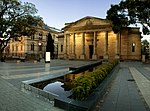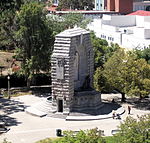South Australian Museum
1847 establishments in AustraliaAdelaide Park LandsEngvarB from May 2022Ethnographic museumsFossil museums ... and 3 more
Museums in AdelaideNatural history museums in AustraliaUse Australian English from August 2015

The South Australian Museum is a natural history museum and research institution in Adelaide, South Australia, founded in 1856 and owned by the Government of South Australia. It occupies a complex of buildings on North Terrace in the cultural precinct of the Adelaide Parklands. Plans are under way to move much of its Australian Aboriginal cultural collection (the largest in the world), into a new National Gallery for Aboriginal Art and Cultures.
Excerpt from the Wikipedia article South Australian Museum (License: CC BY-SA 3.0, Authors, Images).South Australian Museum
North Terrace, Adelaide Adelaide
Geographical coordinates (GPS) Address Website External links Nearby Places Show on map
Geographical coordinates (GPS)
| Latitude | Longitude |
|---|---|
| N -34.920783 ° | E 138.603017 ° |
Address
South Australian Museum
North Terrace
5000 Adelaide, Adelaide
South Australia, Australia
Open on Google Maps






